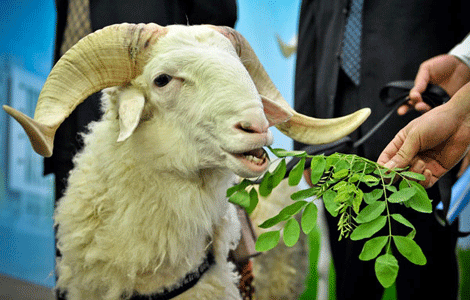
Chinese truffles have been so popular in the last decade that natural reserves are now seriously threatened. The light on the horizon is a research farm that has successfully cultivated these precious fungi. Guo Anfei reports from Kunming.
Yunnan province has produced its first batch of cultivated black truffles, and experts say they hope the fungi will be available on the commercial market a few years later.
Researchers at the Kunming Institute of Botany under the auspices of the Chinese Academy of Sciences have worked on the plantation since 2001, and their efforts finally paid off late last year when they harvested their first truffles.
 |
|
Thick slices of Chinese truffles are infused in Chinese wine and served as an aperitif to wake the taste buds. Photos by Guo Anfei / China Daily |
"Because of the high market demand, people have picked the wild fungus carelessly, depleting natural reserves to levels that are dangerously near extinction," says Liu Peigui, researcher, Kunming Institute of Botany.
He is the main motivator behind the project, and has dedicated much of the last 12 years to the research of truffle cultivation.
Currently, the institute has 33 hectares of black truffles cultivated in Yunnan. Each hectare can produce 300 to 450 kg of black Chinese truffles per year when the plantation is matured.
In China, truffles are found in the wild mainly in Sichuan and Yunnan.
Truffle plantations first started in Spain, France and Italy, and now, the United Kingdom, Germany, Finland, Sweden, Canada, United States, New Zealand and Australia also cultivate the valuable fungi.
"Chinese black truffle yields are low. They grow slowly, and are very exacting in terms of natural conditions," Liu says. Over-harvesting has caused the natural occurrence of truffles to distinctly drop, and in recent years, they have become increasingly rare.
Zhou Zhongping, the chairman of Chuxiong Honggui Green Food Co Ltd, is a major supplier of the natural fungus. He says Yunnan's wild truffle resources have been severely strained since 2000.
Indiscriminate picking of truffles before they have matured is one of several reasons why.
Truffles that can grow up to 300 to 500 grams are being picked when they are only 10 to 20 grams. Foragers dig up the truffles carelessly, damaging the underground mycelia or root systems that will produce truffles in the following year.
While the truffles should only be harvested from November to February at their peak, eager pickers are harvesting them as early as September, or August, or even earlier in June or July.
Zhou's company produces and exports environmentally friendly food from Yunnan, a province that produces more than half of the world's wild mushroom varieties. Two-thirds of China's mushrooms are found here.
In the poorer agricultural regions in the north, truffle and other wild edible mushroom harvesting has become a major source of income. The export of wild fungus has become a mainstay of Yunnan's economic development and the province plans to produce 360,000 tons of edible fungus by 2015, with a turnover of 10 billion yuan ($1.61 billion).







